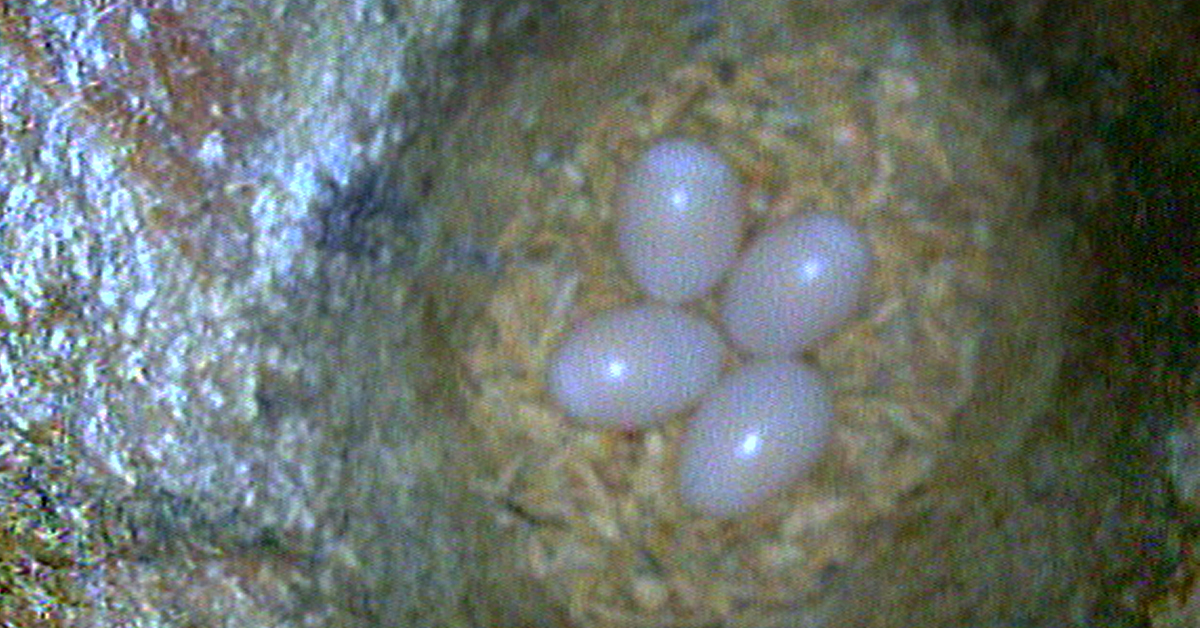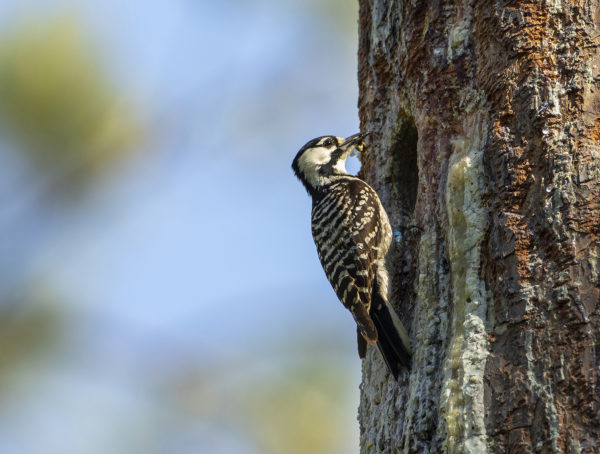
The four red-cockaded woodpecker eggs at Big Woods Wildlife Management Area.
By Jessica Ruthenberg, DWR Watchable Wildlife Biologist
Exciting news from the Virginia Department of Wildlife Resources’ Big Woods Wildlife Management Area! On Thursday April 23, DWR biologists confirmed that the WMA once again harbors an active red-cockaded woodpecker nest—this year with four eggs!
Red-cockaded woodpeckers are a federally endangered species, making these four eggs particularly special. The eggs were found during a nest check of the same tree cavity utilized by last year’s nesting pair, which had two eggs and produced two chicks.

The red-cockaded woodpecker female feeding her nestlings in 2019. Photo by Lynda Richardson/DWR
This is only the second nesting attempt by red-cockaded woodpecker documented at Big Woods WMA. After years of prescribed burns and strategic tree-thinning to restore Big Woods to the open pine savanna habitat required by this species, DWR is thrilled that the WMA continues to meet the birds’ needs. The WMA is also only one of three properties in Virginia with red-cockaded woodpeckers (the others being the neighboring Piney Grove Preserve and also the Great Dismal Swamp National Wildlife Refuge), making this nest a true conservation success story for the Commonwealth.

Red-cockaded woodpecker viewing area in Big Woods Wildlife Management Area. Photo by Lynda Richardson/ DWR
Red-cockaded woodpeckers sometimes lay up to five eggs in a clutch, so it’s possible that these birds may lay an additional egg. Incubation begins before their clutch is complete, with an unusually short incubation period of just 10 to 11 days!
We anticipate these eggs could hatch any time between the end of April and the beginning of May. DWR will continue to check the nest every seven days to determine its status.
How to Support Red-cockaded Woodpeckers in Virginia

- Purchase a Restore the Wild Membership to support the DWR’s habitat restoration work, such as that accomplished at Big Woods WMA. The membership also serves as your pass to visiting Big Woods WMA and over 40 other WMAs throughout the Commonwealth.
- Consider participating in a Safe Harbor Agreement, if you are a landowner with property adjacent to Piney Grove Preserve, Big Woods WMA, or Great Dismal Swamp National Wildlife Refuge.
- If visiting red-cockaded woodpecker viewing areas, such as at Big Woods WMA, please stay out of the marked stands of trees that hold the woodpeckers’ cavities. Do not approach, pursue the birds, or play callback recordings—all of which are considered harassment of this endangered species.
- To learn more about Red-cockaded Woodpeckers and their history in Virginia, visit their species profile on the DWR website.
*DWR acquired Big Woods WMA through funds obtained from the U.S. Fish and Wildlife Service’s Recovery Land Acquisition Grant, specifically in service of conservation for the federally endangered Red-cockaded Woodpecker.



